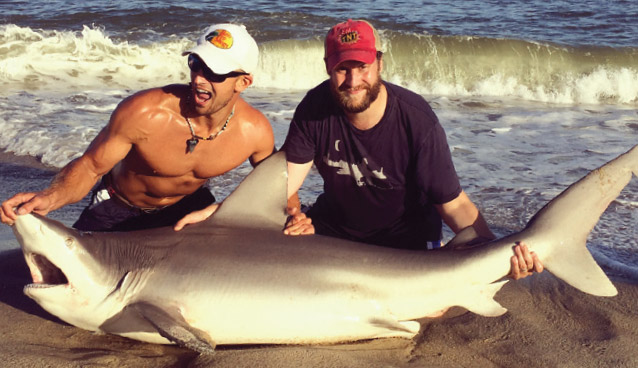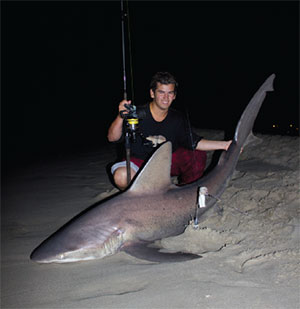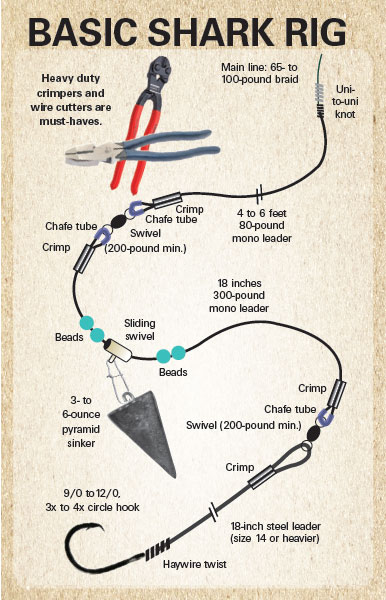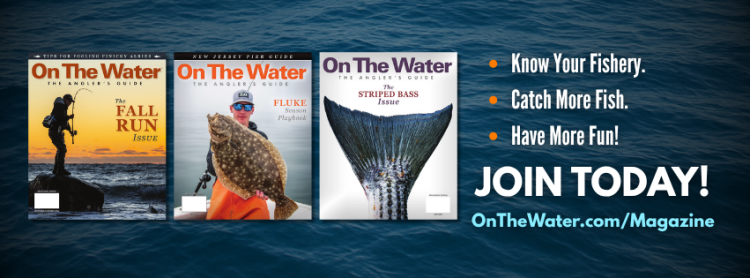
Elliot Sudal was just another hardcore New England fisherman with a particular passion for catching sharks when a video of him wrestling a big sandbar shark from the Nantucket surf went viral. Millions of views later, he found himself making the rounds on national morning shows and appearing on the evening news, and was quickly given the nickname “The Shark Wrestler.”
Well before gaining his thousands of followers on Instagram, Sudal had caught, tagged, and released hundreds of sharks in the Northeast, Florida, and the Caribbean. As a licensed captain, he guided private vessels across the country and ran shark-tagging charters in the Caribbean.
He also founded the Nantucket Shark Tagging Club and worked with NOAA’s Apex Predator Tagging Program to promote shark conservation, tagging, youth education, and teaching anglers to safely catch sharks from the beach. (The club has hundreds of members and landed 130 sharks in 2014.) Furthering shark research and conservation is at the core of all his shark-fishing efforts, and he will be collaborating with shark researchers this summer on Nantucket.
Sudal is currently writing a book on land-based shark-fishing methods, which he sums up in one sentence: “Toss a big chunk of bait out on a large hook and wait for a shark to pick it up.” However, the secret to success definitely is in the details. To increase your chance of hooking up and, most importantly, releasing the shark unharmed, follow his advice for getting started with shore-based sharking.
– Kevin Blinkoff
Sandbar sharks, known locally as brown sharks, are a highly migratory species found in subtropical waters around the world. The sandbar sharks we see in southern New England likely spend the winter months near Florida, the Bahamas, and the Gulf of Mexico. They arrive in Nantucket waters at the end of June, and their numbers seem consistent through early September. The Cape and Islands is the northernmost extent of their habitat in the North Atlantic.
Old-time islanders have told me that, years ago, sandbar sharks were so numerous on Nantucket that you would frequently see schools of them cruising the beach all summer long. Unfortunately, their numbers have been greatly affected by overfishing and from being targeted for their large fins.
Like many sharks, sandbars have a slow growth rate, a long gestation period (between 8 and 12 months), and give birth to small litters of pups. As a result, they are highly vulnerable to fishing pressure. Currently, they are listed by NOAA as a prohibited species and must be released by recreational anglers.
Fishermen can help scientists gather information about sandbar shark biology and aid in their recovery by participating in the NOAA Apex Predator Tagging Program. Contact the program at sharkrecap@ noaa.gov and you’ll receive a tagging kit containing numbered tags on self-addressed return postcards for recording tagging information along with a tagging needle and instructions.
Rod and Reel Selection

The majority of the sandbars I catch are females in the 5- to 7-foot range, and the largest I’ve landed was 8½ feet and weighed around 250 pounds. They are big, powerful animals, and you need heavy tackle to land them.
There are a variety of rods suitable for shark fishing in the surf. Your setup should be able to toss at least 8 ounces 50 feet into the surf. There are plenty of surf rods that can handle such a load (even if rated for slightly less). Longer surf rods also keep your line higher and out of the weeds and waves.
I prefer using large spinning reels when targeting sandbars. The most important features you’re looking for on a spinning reel for sharks is high line capacity (300 yards of 65-pound braid is the minimum) and at least 25 pounds of drag. A quality reel is worth the investment— they last longer, perform better, and feel smoother.
Line & Leader
I believe that using braided line in this situation is highly advantageous. Reels can hold at least twice as much braid as monofilament, and the braid will have a much higher breaking strength. Braid casts farther and does not stretch, giving you a powerful hookset, and its smaller diameter cuts through the water better.
Braid comes in many colors, brands, and styles. I like high-visibility colors, so it is easier to see which direction the shark is moving. Hollowcore line is excellent because it allows you to splice leaders into it, creating a seamless connection. I would suggest 65- to 100-pound test for sandbar sharks.
Your setup is only as strong as its weakest link, and in this situation it is most likely going to be your connection between the leader and the braided main line. Unless you are using hollowcore line, you will need to attach a 4- to 6-foot section of leader material with a knot.
You can use monofilament or fluorocarbon leader material. There are many applications in fishing where the low visibility of fluorocarbon is a big advantage, but hooking sandbar sharks from murky water off the beach isn’t one of them. If you choose monofilament, use a dedicated leader material. I recommend Momoi’s Hi- Catch soft nylon mono leader, followed by Ande monofilament leader material.
The leader provides shock absorption and stretch, cushioning the shark’s headshakes and twitches. It also provides abrasion resistance. Sharkskin is essentially sandpaper, and when the shark is swimming directly away from you, the leader will be making contact with its body. Braid will definitely not hold up to this.
The absolute best connection is made with leader material spliced directly into hollowcore braid. The next best is using a Bimini twist to connect a pre-made wind-on leader, but they can be pricy. The simplest, most costeffective way is to tie your leader to your mainline. I generally use a simple uni-to-uni knot, but the slim beauty knot moves more smoothly through the guides. I use 80- to 100-pound leader material for sandbar sharks. (It is basically impossible to tie a proper knot with anything heavier.)
The rule of thumb when it comes to leaders is that they should be longer than the shark you are trying to catch. I usually shoot for 5 feet of leader, figuring there will be another 2 to 3 feet of wire.
Shark Rigs
 Making your own shark rigs can be just as satisfying as tying your own flies. You can make them as simple or as ornate as you would like, so experiment with different types of wire, mono, hooks, weights, swivels, beads, and rattles.
Making your own shark rigs can be just as satisfying as tying your own flies. You can make them as simple or as ornate as you would like, so experiment with different types of wire, mono, hooks, weights, swivels, beads, and rattles.
Start with a 12- to 16-inch section of heavy mono with a weight, beads, and chafe gear strung through it. Crimp both ends with chafe tubing and a swivel. Place a sliding fishfinder swivel in the weight section, and then attach a pyramid sinker to that.
The chafe tubing and beads serve as shock absorbers from the weight banging against the crimp during a long battle. The beads clicking around underwater can also cause a curious shark to inspect your bait.
Attach a wire bite leader and hook to the weighed mono section. Singlestrand stainless steel wire is readily available, easy to use, and connects with a simple haywire twist. However, it kinks easily and needs to be replaced after most shark battles.
The amount of wire you choose to connect to your weighted mono section is a personal preference. The shorter the distance between your weight and hook, the farther you will be able to cast it. Eighteen inches of wire should be considered the minimum, and three feet would be the maximum.
Hooks in the 9/0 to 12/0 range work the best. Make sure your hooks are 3x or 4x reinforced. A tremendous amount of pressure will be focused on this small piece of metal for a long period of time, so don’t settle on a cheap, thin hook.
The two options are circle hooks and J-hooks. Circle hooks have a lower chance of gut-hooking the shark. Jhooks, if fished attentively, generally will not gut-hook them either. Go with circle hooks if leaving the rod in a sand spike.
Attach your hook to the rest of your rig with a haywire twist and attach the rig to your mainline leader with an improved cinch knot.
When your setup is rigged, give it a test. I like to hang the hook from the hitch of my truck, let out some line, pull it tight and apply pressure at various distances to test the connections and give me a sense of how much drag to set.
Bait Selection
Sandbar sharks feed on skates, eels, bluefish, sea bass, squid, and crustaceans. I have caught almost every shark on strips of fresh bluefish. Bluefish is easy to catch, oily, and holds a hook well. Fresh bait is preferable to previously frozen, as the flesh is firmer and produces more scent. Cut the fish into strips, as opposed to chunks, and leave the skin on. A strip about 10 inches long and 3 inches thick moves nicely in the current. Push the hook through twice and try to hide it on a J-hook, but always leave the point exposed on a circle hook. Strips of false albacore rigged in the same fashion work great, and fresh, dead eels and menhaden are also productive.
Where and When

Sandbar sharks show up in southern New England when the water reaches about 60 degrees. Shallow, sandy areas warm up first in the spring. Wind direction, temperature, waves, tide, water clarity, moon phase and other weather-related factors play a big role in how willing to bite the sharks may be.
It’s an accepted belief among Northeast shark fisherman that an easterly wind turns off the bite. I have yet to find an exact reason why, but in my experience this holds true. Cold snaps, usually accompanied by northerly winds, can have a similar effect. However, the period right before a front can be incredibly productive. Waves produced by wind or offshore swells can make keeping a bait where you want it very difficult. Fishing in crashing surf is frustrating and rarely effective. Additionally, landing a shark in large, crashing waves is unsafe.
Contrary to what I have been told my entire fishing career, the shark fishing around the beaches of Nantucket seems to be just as good during the day as at night. My best luck tends to be right around sunset, but I focus more on how the tides are moving. Also, contrary to shark fishing offshore and down south, the bite is better when the tide is near slack. This may be unique to sandbar sharks off certain spots around Nantucket, but the most consistent bite for me has been during times of minimal water movement.
I also recommend fishing around slack tides because it is much easier to keep a bait in place. A weedy, fast-moving tide is frustrating to fish.
Hooking and Fighting
Getting the hang of casting heavy baits can be a bit tricky–between the lead and bait, your rig can weigh over 10 ounces. The farther you can cast it out, the better. I’ve seen sharks on Nantucket cruising right in the wash, but most of the time they seem to prefer deeper troughs between sandbars and drop-offs.
You will know pretty quickly if the amount of lead you have on your rig is sufficient to hold your bait in place. One of the advantages to using sliding swivels is the ease of changing your weight out.
I prefer to hold the rod in my hands with the bail open and the drag set heavy. I always like to feel exactly what my rig is doing, keeping moderate tension on the line. Should it drift sideways, get covered in crabs, or get picked up, I want to know as soon as possible. If you are fishing with J-hooks, you have about 3 to 5 seconds to set the hook before the shark swallows it and potentially becomes gut-hooked, so reaction time is important.
Leaving the rod in a sturdy, wellburied sand spike is an option, but only recommended with circle hooks. Set the drag as light as possible, essentially in freespool (or actually in freespool if you are using a bait-feeder or a conventional reel). On spinning reels, you will have to quickly open the bail, tighten the drag down, flip the bail back and set the hook in a matter of seconds, so be aware this can be a tricky maneuver to master.
Sandbar sharks tend to hit hard, picking up the bait and taking off. If you are holding the rod with the bail open, it’s an unmistakable feeling. Line will be rapidly spooling off your reel and you can feel the tension of the shark on the other end. With a J-hook, set the hook after about 3 seconds of consistent and committed pulling. I recommend pointing the rod tip in the direction the line is pulling, flipping the bail, and doing a drastic set as soon as line goes tight. It’s a big shark, strong line, large hook, and heavy rod, so put some muscle into the hookset.
Circle hooks don’t need to be “set,” as the exposed point will catch the corner of the shark’s mouth and become embedded as it swims away with the line tight.
Surfcasting for large sandbar sharks produces one of the most exciting battles you can have from the beach. A sandbar will pull off extraordinary runs of 200- plus yards, hunker down and hold its position, and occasionally even breach. During the battle, the most important factor is keeping tension on the line at all times. Depending on how you fight them and the amount of drag you’re comfortable putting on your setup, the fight can last from 10 minutes to an hour.

After a quick photo, gently guide it back into the water.
Landing and Releasing
Landing sharks on the beach can be dangerous, and no fishing experience is ever worth causing serious injury to yourself, others, or the shark. You will have to remove the hook from the shark’s jaw and return it to the water, so you will have to go into the surf and pull the shark at least partially onto the beach. Do not attempt this if the surf is rough, or if you are at all nervous about grabbing a large shark from the water. Sharks can move extremely fast and inflict injury to yourself and others, even when out of the water.
The basic idea here is to bring the shark as close in as possible and get him to coast onto the sand with an incoming wave. Once the shark is partially beached, you will need to grab it at the base of the tail and gently bring it up a few feet out of the crashing waves. Be as gentle as possible and try to slide it up as the wash from a wave comes in.
You should have long-handled pliers, wire cutters, and bolt cutters on hand. Give yourself a maximum of two minutes to remove the hook and return the shark to the water. Most large sharks are rather docile when up on the sand, but that does not mean they cannot turn on you at lightning speed. If you position yourself directly facing the shark head-on, you can lift its mouth open by gently bracing its nose and pushing upward, giving you access to the hook. If the hook is in such a position that you cannot remove it, use bolt cutters to cut the hook in half and allow it to slide out easily. If the hook has been swallowed or it’s taking you too long to get it out, snipping the wire might be the safest option for the shark. Make sure to cut the wire as close to the hook as possible, and avoid this unless absolutely necessary.
When the hook is free, quickly snap your photos and return the shark to the water. Slide it into the wash from a wave and gently bring it back into the surf. When it is in a foot or two of water, spin it so its head is pointing offshore and guide it back toward deeper water. More often than not, they will take off rather quickly once they get a little water over their gills and get reoriented.
Responsible Sharking
Always be aware of how you are presenting the sport of land-based sharking. Never set up near where people are swimming. If you get a crowd of beachgoers while you’re hooked up, be respectful and ready to explain that sandbar sharks are docile scavengers that have never attacked a human unprovoked. Treat the shark with the utmost respect, and return it quickly to the water.
Sandbar sharks are a protected species and a conservation-based mindset is necessary if you are going to take part in this sport. After you have experience with landing a few sharks, consider becoming part of the Apex Predator Tagging Program. It’s a federally funded tagging program that’s been going on for over 50 years, overseen by NOAA. It contributes important data on migration and growth patterns of many shark species throughout the Atlantic. It is free to join, and is a good cause. Visit NOAA’s website to enroll.



Great article. You have inspired me to get out and try this (new to me) sport.
why would your bring the shark on the beach . being protected they should be released while still in the water, the author should know better as this poses a risk to the shark. bring it to waters edge, snap your trophy pictures and then cut the line let him live another day
Cut the line? You pay 12$ for a single hook and then spend all that time building a rig, then tell me you just wanna cut the line… Also, you pretend to be so concerned for the shark’s well being but you want to turn it loose with a giant stainless hook in its mouth? Do you hear the words that are coming out of your mouth?
To conservation shark hunt means do whatever it takes to insure the best safety of the fish, and therefore there are NO concerns about losing entire rigs if need be to insure getting the shark back safely into the water. Ethical shark hunters do NOT use stainless steel hooks, we use forged iron circle hooks that will dissolve in salt water.
I have been wrestlin sharks since you uns was in the Huggies, and lemme tell yas somethin…I can tell by this article this man is a CERTIFIED Sharkologist and has been in all kinds of situations (putting sharks in a head lock, bi*ch-slapping them, throwing a left jab and knocking a few molars out, etc) and is nothin but Perfeshinal about it. If sharks “Float” away, belly-up, after being released and look dead, I can assure you they are just faking to get us sharks wrestlers in trouble and such. Then to top it off, they stalk us with underwater binoculars and at the right time come take a chunk outta our ass for good measure. Now that I really let your comment sink in, the next white pointer or tiger I catch I am gonna take my jet boat out to him about 100 yards from the beach, hook up to his gangster ass, and give him skiing lessons backards…yeah…you did this buttholio.
I don’t doubt your good intentions, but it doesn’t look like the way you are handling the sharks and encouraging others to handle sharks is in the best interests of the sharks you are attempting to help. According to the NOAA guidelines, you are should avoid holding the shark’s mouth open for taking photos, which is exactly what you are doing. Please see page 5 of the pdf in the attached link. It also clearly states that taking the sharks out onto the sand should be avoided. This is also something you are clearly doing. Again, I understand that you are attempting to help the sharks by tagging and general education, but you really should reconsider your methods and if you are actually hurting the animals you are trying to protect. I don’t doubt your good intentions, but it doesn’t look like the way you are handling the sharks and encouraging others to handle sharks is in the best interests of the sharks you are attempting to help. http://nefsc.noaa.gov/nefsc/Narragansett/sharks/cstpbooklet.pdf
I think he knows what he’s doing
Get a life and fish…stop crying.SHARKS R TUFFER THEN U COULD UNDERSTAND…GO BACK TO READING NEWSDAY
Considering how he takes time to pose for selfies and the way he acts while the animal begins to suffocate. I’d much rather smash Mr. Sudal’s nose, then toss him in the ocean right behind the shark. It’s one thing to be a scientist and tag these amazing creatures, its another to gloat with narcissistic enthusiasm while the animal suffocates. Real scientific taggings are done quickly and effectively, photos and video are taken of the process, during the process. And much greater enthusiasm is shown helping and watching the shark swim to safety. Not a before and after selfie, while posing like a jackass.
Regards,
The Man who may one day smash your face off a rock.
piss off
Do you look up these articles just so you can try to tell people that catching sharks is”bad” or is your life really that #@($ed up and you have nothing else to do? Or is it that you just want people to think you’re a badass bc you want to “smash someone’s nose in with a rock?
thanks asshole.
Shut up vegan
As someone who has personally met Mr.Sudal he catches the sharks for research and to learn about them not to gloat on social media. His fame came after his love for fishing and sharks not the other way around.
Which beachs to you suggest trying on the south side of cape cod?
After that tough guy who threatened to smash a man’s face off a rock, you still want to go sharking? I wouldn’t risk it. But to answer your question, I would try vineyard sound, somewhere along surf drive
To the guy smashing faces on rocks if at all your a fisherman such you prolly are since you read the article. You have took a fish out of the water to take a picture. Dude has more people that LIKE him that you prolly have ever seen. So get a life and threaten your dog. You prolly will get a better response, hell he might even give your weird @&$ a kiss. lol looser.
Guy takes the time to write this awesome article and all that you internet tough guys have to say is how he is mistreating the shark ,and how your going to “bash his face” lol but that would require you being tough in real life and not just behind your keyboard which I can guarantee your not. That being said about these losers I thought it was a great article and very informative thank you…
I agree reading these comments from these losers gets my blood boiling these are the same guys who would never say a word in real life
William D. – They’ve been getting big ones in harwich. Try a sound side beach with jetties. Rob Conery at the CC Times often provides weekly updates.
But be aware apparently there’s a tough guy out there somewhere who smashes faces with rocks with virtual precision, a real scary dude indeed.
To the PETA freak who loves sharks: how many sharks do you think are caught from shore on Cape Cod per year? One dozen? Even if all of those sharks died upon release does that represent a significant percentage of their species’ population?
Good article. Thanks for the information.
Thanks for the great read Eliot. Disregard all the haters out there, they only dream they had the skill, patience and muscle to catch these sharks and “bash your face on rocks.” Not sure if you guys have seen the pictures of Elliot but if you were a real man (Patrick Kelly & Kevin), then I challenge you to post a pic of yourself with your shirt off while not controlling a sharks nose and wading in 3′ of water. Kevin you can update the PDF after on how stupid the method was that you decided to take word for word in a government coloring book.
Keep up the good work, i’ve used these techniques here on the West Coast and they’ve helped with landing some nice Leopard and 7 gills. Tight lines!
We had a great year for sharks in the surf on Long Island Many landed on Smith Point Beach!! No luck for me but plenty of strippers,blues and weeks to keep me busy!!!! Good luck in 2017
I am a Hatian born Miami resident. When in Hatai, I did a substantial amount of Shark Fishing. We never killed a shark, as they are seen as respected creatures, and in my village it was said to kill a shark was to warrant a future attack.
I feel these animals if landed in a sufficient period of time on heavy tackle, and with a Circle hook, they almost have to be brought onto shore to remove the hook quickly and keep the animal safe. Trying to preform this at nighttime in the water sounds very dangerous to me .
These animals are extremeley tough and I have only heard of them dying when swollowing J hooks, intentionally gaffed, clubbed, or macheteded.
Just a Hatian point of view.
Andre
Anyone who is saying what these PETA dumb asses are saying are clearly people who have never caught a shark and dont know what they are talking about. you know just get in the water and try to kiss the shark while your’e at it
Thanks for a great read, very informative. I will be beach fishing for sharks October 2017 in Cape Verde so all the info I can gather together the better.
I too have a fishing blog “lee swords fishing” and also gather my fair catch of haters, do what Imdo and block them
good luck and tightlines
lee
Such tough guys here ” I’d much rather smash Mr. Sudal’s nose, then toss him in the ocean ” (Patrick Kelley) I don’t know patrick, I’ve seen your rather sizable beer gut. Mr. Sudal seems to be in rather good shape, not sure who would get their nose smashed on rocks. Either way its not good to run your mouth and threaten people. Shows you to be a child, ignorant, or both. Grown men simply agree to disagree and leave it at that. If you think otherwise go talk to your dad, uncle or other grown MAN in your family about it. I’m just another guy on the internet pointing out how silly you sound when you threaten people. Hopefully the real men in your family/life straighten you out.
Great article!.. this information saves me a lot of trial and error!..as a tournament bass fisherman for 20yrs..ive never done any surf fishing… just acquired an old 11′ heavy action ugly stik..and a penn 9500 spinfisher (USA made)..in mint condition.. I’m gonna use your recommendations and go from there!..thanks!
I would like to know what you suggest for rod length and brand for open face. I see you prefer wire leader to cable any reason behind that.
And to the Peta people that have nothing better to do than bash a great fisherman get a life.
Any suggestions on reels and what lb test I should use. We caught a shark off the sunset beach in cape may using 50lb test. The next sandbar we hooked into turned and snapped the line clean off.
ok, good article!, but Elliot does not put marks…Do you already have equipment?. There are more than 20 models!. REEL BUDGET 150$, 300 or 1000?
cheap? (hollow braid is good option) old tuff line, suflix832, jerry brown, j-braid 65lb with spinfisher8500, lethal100, bg8000, old spheros/saragosa18000………80lb braid(or 100) and better reels for 200lb big sharks are spheros/gosa20k, cabo120 or old catalina6500. Also monsters offshore(not instant anti-reverse), slammer and V10500-43oz!
Other options but expensive: 600$ isla7k, old stella fa 20k/saltiga/expedition6500; And 800-1200$!! classic van staal or ZB, old twinspin SR50, torque, stella sw 20k, dogfight8000 or makaira30k(100lb/570yds!!, as stella 30k but it rotor problems).
BG and makaira have fast ratio/IPT 53″ and 65″!. Better low ratio 4.2-5=more power
Do you have any insight as to fishing on the Jersey shore? I have heard from Atlantic City to Cape May is fish-able, but I have not heard about to much sharking north of Atlantic City.